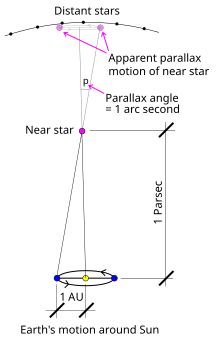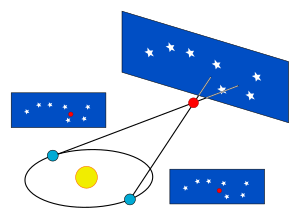Parsec
| Parsec | |
|---|---|
 A parsec is the distance from the Sun to an astronomical object that has a parallax angle of one arcsecond (not to scale) | |
| General information | |
| Unit system | astronomical units |
| Unit of | length/distance |
| Symbol | pc |
| Conversions | |
| 1 pc in ... | ... is equal to ... |
| petametres | |
| imperial US units | 1.9174×1013 mi |
| astronomical units | 2.06265×105 au 3.26156 ly |
The parsec (symbol: pc) is a
The word parsec is a
In August 2015, the
History and derivation
Imagining an elongated
One of the oldest methods used by astronomers to calculate the distance to a

The parallax of a star is defined as half of the
The use of the parsec as a unit of distance follows naturally from Bessel's method, because the distance in parsecs can be computed simply as the
Though it may have been used before, the term parsec was first mentioned in an astronomical publication in 1913. Astronomer Royal Frank Watson Dyson expressed his concern for the need of a name for that unit of distance. He proposed the name astron, but mentioned that Carl Charlier had suggested siriometer and Herbert Hall Turner had proposed parsec.[4] It was Turner's proposal that stuck.
Calculating the value of a parsec
By the 2015 definition, 1 au of arc length subtends an angle of 1″ at the center of the circle of radius 1 pc. That is, 1 pc = 1 au/tan(1″) ≈ 206,264.8 au by definition.
- , and
- (exact by the 2012 definition of the au)
Therefore,
Therefore,
Approximately,
In the diagram above (not to scale), S represents the Sun, and E the Earth at one point in its orbit (such as to form a right angle at S[b]). Thus the distance ES is one astronomical unit (au). The angle SDE is one arcsecond (1/3600 of a degree) so by definition D is a point in space at a distance of one parsec from the Sun. Through trigonometry, the distance SD is calculated as follows:
Because the astronomical unit is defined to be 149597870700 m,[10] the following can be calculated:
| Therefore, 1 parsec | ≈ 206264.806247096 astronomical units |
| ≈ 3.085677581×1016 metres | |
| ≈ 30.856775815 trillion kilometres | |
| ≈ 19.173511577 trillion miles |
Therefore, if 1 ly ≈ 9.46×1015 m,
- Then 1 pc ≈ 3.261563777 ly
A corollary states that a parsec is also the distance from which a disc that is one au in diameter must be viewed for it to have an angular diameter of one arcsecond (by placing the observer at D and a disc spanning ES).
Mathematically, to calculate distance, given obtained angular measurements from instruments in arcseconds, the formula would be:
where θ is the measured angle in arcseconds, Distanceearth-sun is a constant (1 au or 1.5813×10−5 ly). The calculated stellar distance will be in the same measurement unit as used in Distanceearth-sun (e.g. if Distanceearth-sun = 1 au, unit for Distancestar is in astronomical units; if Distanceearth-sun = 1.5813×10−5 ly, unit for Distancestar is in light-years).
The length of the parsec used in
Usage and measurement
The parallax method is the fundamental calibration step for
ESA's
Distances in parsecs
Distances less than a parsec
Distances expressed in fractions of a parsec usually involve objects within a single star system. So, for example:
- One astronomical unit (au), the distance from the Sun to the Earth, is just under 5×10−6 pc.
- The most distant . Voyager 1 took 46 years to cover that distance.
- The Oort cloud is estimated to be approximately 0.6 pc in diameter
Parsecs and kiloparsecs
Distances expressed in parsecs (pc) include distances between nearby stars, such as those in the same
- Proxima Centauri, the nearest known star to earth other than the sun, is about 1.3 parsecs (4.24 ly) away by direct parallax measurement.
- The distance to the open cluster Pleiades is 130±10 pc (420±30 ly) from us per Hipparcos parallax measurement.
- The centre of the Milky Way is more than 8 kiloparsecs (26,000 ly) from the Earth and the Milky Way is roughly 34 kiloparsecs (110,000 ly) across.
- ESO 383-76, one of the largest known galaxies, has a diameter of 540.9 kpc (1.8 million ly).
- The Andromeda Galaxy (M31) is about 780 kpc (2.5 million ly) away from the Earth.
Megaparsecs and gigaparsecs
Astronomers typically express the distances between neighbouring galaxies and
One gigaparsec (Gpc) is
For example:
- The Andromeda Galaxy is about 0.78 Mpc (2.5 million ly) from the Earth.
- The nearest large galaxy cluster, the Virgo Cluster, is about 16.5 Mpc (54 million ly) from the Earth.[18]
- The galaxy RXJ1242-11, observed to have a supermassive black hole core similar to the Milky Way's, is about 200 Mpc (650 million ly) from the Earth.
- The largest known structurein the universe, is about 3 Gpc (9.8 billion ly) across.
- The particle horizon (the boundary of the observable universe) has a radius of about 14 Gpc (46 billion ly).[19]
Volume units
To determine the number of stars in the Milky Way, volumes in cubic kiloparsecs
In physical cosmology, volumes of cubic gigaparsecs[c] (Gpc3) are selected to determine the distribution of matter in the visible universe and to determine the number of galaxies and quasars. The Sun is currently the only star in its cubic parsec,[c] (pc3) but in globular clusters the stellar density could be from 100–1000 pc−3.
The observational volume of gravitational wave interferometers (e.g., LIGO, Virgo) is stated in terms of cubic megaparsecs[c] (Mpc3) and is essentially the value of the effective distance cubed.
In popular culture
The parsec was seemingly used incorrectly as a measurement of time by
In the book A Wrinkle in Time, "Megaparsec" is Mr. Murry's nickname for his daughter Meg.[23]
See also
Notes
- ^ One trillion here is short scale, ie. 1012 (one million million, or billion in long scale).
- ^ a b Terrestrial observations of a star's position should be taken when the Earth is at the furthest points in its orbit from a line between the Sun and the star, in order to form a right angle at the Sun and a full au of separation as viewed from the star.
- ^ a b c d e
1 pc3 ≈ 2.938×1049 m3 1 kpc3 ≈ 2.938×1058 m3 1 Mpc3 ≈ 2.938×1067 m3 1 Gpc3 ≈ 2.938×1076 m3 1 Tpc3 ≈ 2.938×1085 m3
References
- ^ "Cosmic Distance Scales – The Milky Way". Retrieved 24 September 2014.
- ^ Benedict, G. F.; et al. "Astrometric Stability and Precision of Fine Guidance Sensor #3: The Parallax and Proper Motion of Proxima Centauri" (PDF). Proceedings of the HST Calibration Workshop. pp. 380–384. Retrieved 11 July 2007.
- ^ "Farthest Stars". StarDate. University of Texas at Austin. 15 May 2021. Retrieved 5 September 2021.
- ^ doi:10.1093/mnras/73.5.334.suggests Parsec, which may be taken as an abbreviated form of "a distance corresponding to a parallax of one second".
[paragraph 14, page 342] Taking the unit of distance R* to be that corresponding to a parallax of 1″·0 [… Footnote:]
* There is need for a name for this unit of distance. Mr. Charlier has suggested Siriometer, but if the violence to the Greek language can be overlooked, the word Astron might be adopted. Professor Turner - ISBN 978-0387987460.
- ISBN 978-0-691-13026-2.
- High Energy Astrophysics Science Archive Research Center (HEASARC). "Deriving the Parallax Formula". NASA's Imagine the Universe!. Astrophysics Science Division (ASD) at NASA's Goddard Space Flight Center. Retrieved 26 November 2011.
- .
- .
- ^ International Astronomical Union, ed. (31 August 2012), "RESOLUTION B2 on the re-definition of the astronomical unit of length" (PDF), RESOLUTION B2, Beijing: International Astronomical Union,
The XXVIII General Assembly of the International Astronomical Union recommends [adopted] that the astronomical unit be redefined to be a conventional unit of length equal to exactly 149597870700 m, in agreement with the value adopted in IAU 2009 Resolution B2
- ^ International Astronomical Union, ed. (13 August 2015), "RESOLUTION B2 on recommended zero points for the absolute and apparent bolometric magnitude scales" (PDF), RESOLUTION B2, Honolulu: International Astronomical Union,
The XXIX General Assembly of the International Astronomical Union notes [4] that the parsec is defined as exactly (648 000/) au per the AU definition in IAU 2012 Resolution B2
- ^ Pogge, Richard. "Astronomy 162". Ohio State University.
- ^ "The Hipparcos Space Astrometry Mission". Retrieved 28 August 2007.
- ^ Turon, Catherine. "From Hipparchus to Hipparcos".
- ^ "GAIA". European Space Agency.
- ^ "Why is a parsec 3.26 light-years?". Astronomy.com. 1 February 2020. Retrieved 20 July 2021.
- ^ "Galaxy structures: the large scale structure of the nearby universe". Archived from the original on 5 March 2007. Retrieved 22 May 2007.
- S2CID 16483538.
- doi:10.1038/scientificamerican0305-36. Archived from the originalon 10 August 2011. Retrieved 4 February 2016.
- ISSN 0004-637X.
- ^ "'Solo' Corrected One of the Most Infamous 'Star Wars' Plot Holes". Esquire. 30 May 2018.
- ^ Choi, Charlse (5 November 2019). "'Star Wars' Gets the Parsec Wrong Again in 'The Mandalorian'". space.com. Retrieved 6 May 2020.
- ^ "In "A Wrinkle in Time," what is Mr. Murry's nickname for Meg?". Retrieved 6 May 2020.
External links
- Guidry, Michael. "Astronomical Distance Scales". Astronomy 162: Stars, Galaxies, and Cosmology. University of Tennessee, Knoxville. Archived from the original on 12 December 2012. Retrieved 26 March 2010.
- Merrifield, Michael. "pc Parsec". Sixty Symbols. Brady Haran for the University of Nottingham.








